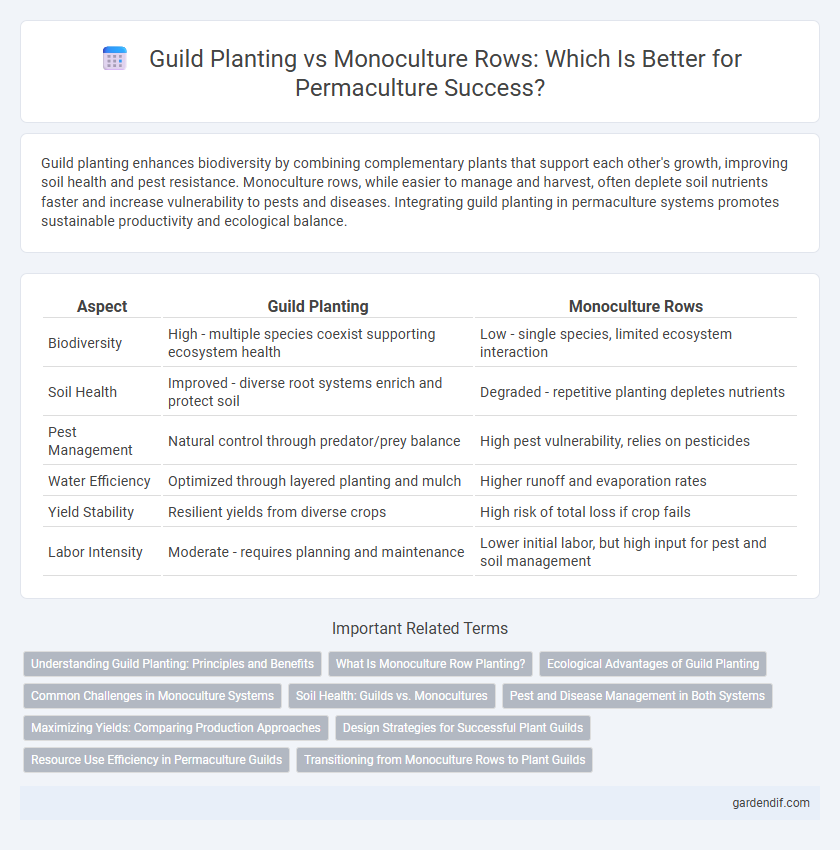
guild planting vs monoculture rows Illustration
Guild planting enhances biodiversity by combining complementary plants that support each other's growth, improving soil health and pest resistance. Monoculture rows, while easier to manage and harvest, often deplete soil nutrients faster and increase vulnerability to pests and diseases. Integrating guild planting in permaculture systems promotes sustainable productivity and ecological balance.
Table of Comparison
| Aspect | Guild Planting | Monoculture Rows |
|---|---|---|
| Biodiversity | High - multiple species coexist supporting ecosystem health | Low - single species, limited ecosystem interaction |
| Soil Health | Improved - diverse root systems enrich and protect soil | Degraded - repetitive planting depletes nutrients |
| Pest Management | Natural control through predator/prey balance | High pest vulnerability, relies on pesticides |
| Water Efficiency | Optimized through layered planting and mulch | Higher runoff and evaporation rates |
| Yield Stability | Resilient yields from diverse crops | High risk of total loss if crop fails |
| Labor Intensity | Moderate - requires planning and maintenance | Lower initial labor, but high input for pest and soil management |
Understanding Guild Planting: Principles and Benefits
Guild planting enhances biodiversity by combining complementary plants that support each other's growth, optimize nutrient use, and improve pest resistance. This method mimics natural ecosystems, promoting soil health and increasing resilience compared to monoculture rows, which rely on single crops and often require more external inputs. By fostering symbiotic relationships, guild planting creates a sustainable and productive environment that conserves resources and boosts yield stability.
What Is Monoculture Row Planting?
Monoculture row planting involves growing a single crop species in uniform rows, maximizing space and simplifying planting and harvesting processes. This method often relies heavily on synthetic fertilizers and pesticides, increasing vulnerability to pests and diseases due to lack of biodiversity. Compared to permaculture guild planting, monoculture lacks ecological balance and resilience, resulting in soil depletion and reduced long-term productivity.
Ecological Advantages of Guild Planting
Guild planting enhances biodiversity by combining multiple plant species that support each other's growth, pest control, and nutrient cycling, unlike monoculture rows that rely on a single crop and often require chemical inputs. This method mimics natural ecosystems, promoting resilience against pests and diseases while improving soil health through complementary root structures and organic matter contribution. The ecological advantages include increased habitat for beneficial insects, reduced erosion, and improved water retention, fostering a sustainable and self-regulating agricultural environment.
Common Challenges in Monoculture Systems
Monoculture systems often face challenges such as soil nutrient depletion, increased vulnerability to pests and diseases, and reduced biodiversity compared to guild planting. The lack of plant diversity in monoculture rows limits natural pest control mechanisms and disrupts ecological balance, leading to higher reliance on chemical inputs. In contrast, permaculture guild planting enhances soil health, supports beneficial insect populations, and promotes resilience by integrating complementary plant species.
Soil Health: Guilds vs. Monocultures
Guild planting enhances soil health by promoting diverse root systems that improve nutrient cycling, increase microbial activity, and enhance soil structure. In contrast, monoculture rows often lead to soil nutrient depletion, reduced biodiversity, and increased vulnerability to pests and diseases. The varied plant species in guilds create synergistic relationships, fostering resilient and fertile soil ecosystems.
Pest and Disease Management in Both Systems
Guild planting enhances pest and disease management by promoting biodiversity, which naturally attracts beneficial insects and creates a balanced ecosystem that suppresses harmful pests. Monoculture rows often suffer from increased vulnerability to pests and diseases due to uniform plant species, leading to rapid spread and higher reliance on chemical controls. Integrating diverse plant species in guilds disrupts pest life cycles and reduces disease incidence more effectively than monoculture practices.
Maximizing Yields: Comparing Production Approaches
Guild planting enhances biodiversity by combining complementary plant species that support nutrient cycling, pest control, and soil health, leading to higher overall yields per area compared to monoculture rows. Monoculture rows focus on single crops, which can simplify management but often result in soil depletion and increased vulnerability to pests and diseases, reducing long-term productivity. Integrating guild planting techniques offers a sustainable strategy to maximize yields through synergistic plant interactions and improved ecosystem resilience.
Design Strategies for Successful Plant Guilds
Design Strategies for Successful Plant Guilds emphasize diverse species assemblages that support mutual growth, pest resistance, and nutrient cycling, contrasting sharply with monoculture rows that deplete soil and heighten vulnerability. Incorporating nitrogen-fixing plants, dynamic accumulators, and pollinator attractors into guilds creates resilient ecosystems that improve productivity and sustainability. Strategic layering of canopy, shrub, herbaceous, and root crops enhances microclimates and resource use efficiency, fostering long-term soil health and biodiversity.
Resource Use Efficiency in Permaculture Guilds
Permaculture guilds maximize resource use efficiency by integrating diverse species that mutually support nutrient cycling, water retention, and pest control, reducing the need for external inputs. In contrast, monoculture rows often rely heavily on chemical fertilizers and irrigation, leading to resource depletion and increased vulnerability to pests. The synergistic plant interactions in guild planting enhance soil health and ecosystem resilience, creating a sustainable system that optimizes energy and nutrient flows.
Transitioning from Monoculture Rows to Plant Guilds
Transitioning from monoculture rows to plant guilds enhances biodiversity by integrating complementary species that support each other's growth and soil health. Plant guilds promote natural pest control, improved nutrient cycling, and increased resilience against environmental stresses compared to single-crop systems. Embracing diverse plant communities in permaculture design optimizes land use efficiency and fosters sustainable ecosystem functions.
guild planting vs monoculture rows Infographic

 gardendif.com
gardendif.com